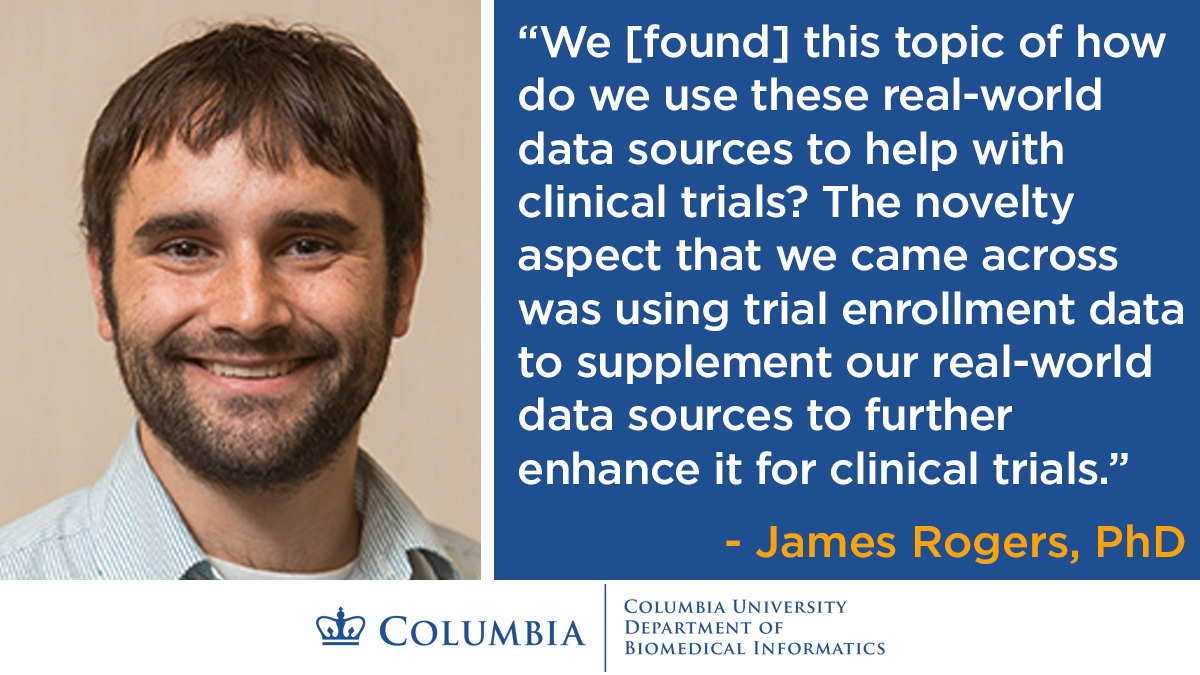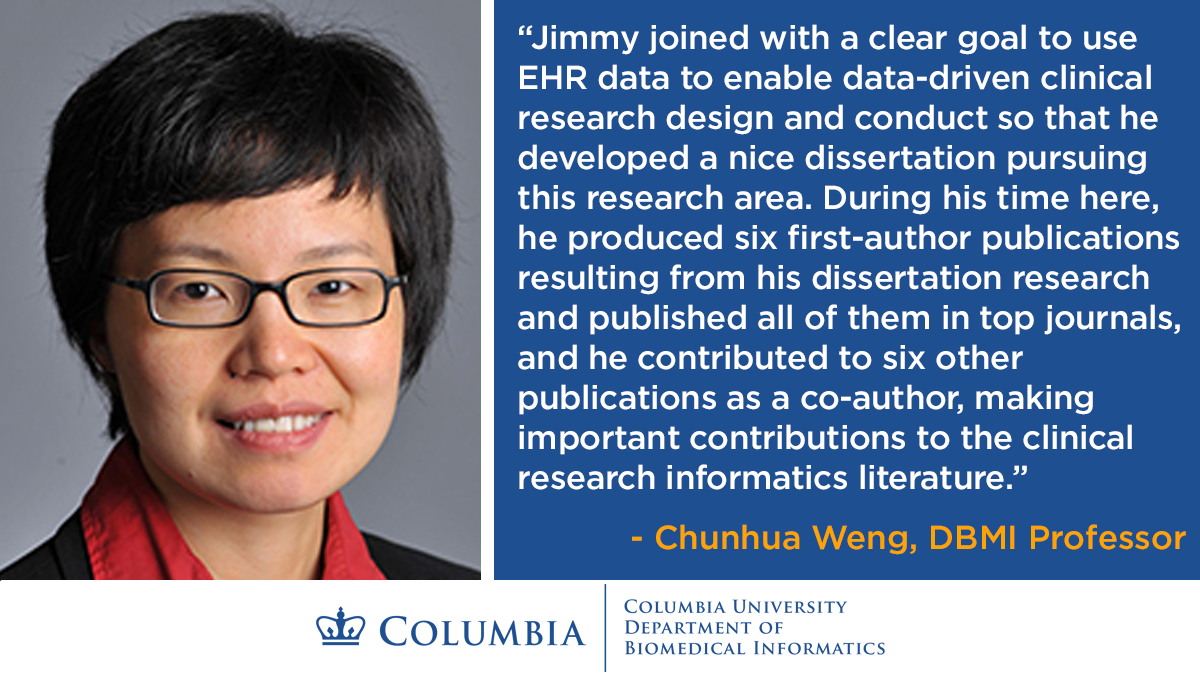PhD Profile: James Rogers
 James (Jimmy) Rogers came to DBMI as an epidemiologist with a desire to improve data quality for medical evidence generation. He believed informatics could be a way to complement the epidemiologic methods he learned in order to find innovative ways to improve the use and validity of secondary data.
James (Jimmy) Rogers came to DBMI as an epidemiologist with a desire to improve data quality for medical evidence generation. He believed informatics could be a way to complement the epidemiologic methods he learned in order to find innovative ways to improve the use and validity of secondary data.
Though it wasn’t a linear path, Rogers eventually found a focus around using real-world data, defined as data relating to healthcare that is routinely collected, to enhance clinical trials. That focus — which included two major perspectives in this area: design (selecting eligibility criteria), and results interpretation (how we use real-world data to improve generalizability assessments) — led him to produce six first-author publications during his time at Columbia.
Rogers connected early with his eventual advisor, Chunhua Weng. They collaborated first on data quality, then researched using PubMed comments to generate evidence and worked on other various projects within her lab, such as exploring enhancements for Criteria2Query.
“Eventually we focused on using my background within epidemiology and real-world data and applying it within this clinical trial environment,” Rogers said. “We ended up finding this topic of how do we use these real-world data sources to help with clinical trials? The novelty aspect that we came across was using trial enrollment data to supplement our real-world data sources to further enhance it for clinical trials.”
Rogers published four papers specifically around this dissertation topic, each of which provide part of the full context of his dissertation work. The background for this research is highlighted in Contemporary use of real-world data for clinical trial conduct in the United States: a scoping review (Journal of American Medical Informatics Association, November 2020), which provided a look at how real-world data has been used for clinical trial conduct.
“When looking through this work, we found opportunities in which we could address challenges when using real-world data for clinical trial use,” Rogers said. “In particular, one was that there are consistent data challenges with real-world data. The second one, which was a surprise, was how few therapeutic trials emerged from our search for trials that implemented real-world data when the trial was actually being executed. Based on these, we focused on therapeutic trials that might not necessarily consider the use of real-world data, as well as trying to address these data challenges. That’s what led to our two aims.”
 Aim 1 focused on using real-world data, specifically electronic health record (EHR) data, from a design perspective, and is addressed in Leveraging electronic health record data for clinical trial planning by assessing eligibility criteria’s impact on patient count and safety (Journal of Biomedical Informatics, March 2022).
Aim 1 focused on using real-world data, specifically electronic health record (EHR) data, from a design perspective, and is addressed in Leveraging electronic health record data for clinical trial planning by assessing eligibility criteria’s impact on patient count and safety (Journal of Biomedical Informatics, March 2022).
“We were seeing if we could provide a more informed data-driven approach for clinical trial eligibility criteria selections,” Rogers said. “We built out different cohorts for different combinations, mapped two parameters [patient count and hospitalization risk] and applied a clustering technique to see what criteria patterns emerged. Based on where the patterns lie can help inform what criteria combinations might be worth considering for future trials.”
The next two papers took both a macro and micro approach to Aim 2, which focused on generalizability. Comparison of Clinical Characteristics Between Clinical Trial Participants and Nonparticipants Using Electronic Health Record Data (JAMA Network Open, April 2021) provided both a landscape overview of what patient populations a set of trials are covering, as well as a perspective of what subgroups might be missing within that set. This cross-sectional study of 1645 clinical trial participants and an aggregated set of 1645 matched nonparticipants found that the trial participants had fewer underlying conditions and less medication use than nonparticipants, and thus a more comprehensive approach to evaluating trials could enhance generalizability.
The micro approach, which focused on individual trials and their own generalizability, is found in Clinical comparison between trial participants and potentially eligible patients using electronic health record data: A generalizability assessment method (Journal of Biomedical Informatics, July 2021). This study compares trial participants to potentially eligible patients while controlling for eligibility criteria, recruitment time, and clinical setting.
“Those two approaches provide a nice complementary perspective for generalizability assessments,” Rogers said. “Overall, the big takeaway here is how real-world data can be used for clinical trials, particularly with this supplement of trial enrollment data, and the avenues that we explored to determine this.”
Rogers was appreciative that Weng was there to explore all of those avenues with him.
“[Chunhua] was a fantastic advisor,” he said. “I appreciated her flexibility and patience, and her willingness to pursue these different ideas and different avenues. I also appreciated how she was amenable to utilizing some of her own research interests and combining it with my own research perspective. I’d particularly like to highlight some of the resources her own lab has developed, such as Criteria2Query. I used some of those to make sure this thesis got finished.”
Like his mentor, Rogers was active in the OHDSI community, an interdisciplinary global community that collaborates through open science to generate real-world health evidence through large-scale analytics. DBMI serves as the central coordinating center for OHDSI, and Rogers attempted to give back to that community.
“OHDSI was a crucial, if not necessary, aspect of my research,” he said. “One thing I wanted to do to give back to the OHDSI community was to provide a different avenue to explore. How can we bring in another data source that people might be overlooking, or not considering, and how can it help our current data sources while leveraging the OHDSI resources?”
Rogers enjoyed his time in the department, both with the faculty that he found helpful with any questions he had, and with his fellow trainees. A particular strength that he appreciated about the department was the wide array of different research ideas that can inspire solutions to problems or even generate new ideas.
“Because the research interests are so diverse, you end up finding avenues or ideas that you didn’t think about at first,” Rogers said. “That can be really helpful for a particular challenge you are trying to overcome, or maybe it helps develop a new research idea.”
 Following his successful doctoral dissertation, Rogers accepted a position as an Associate Principal Scientist at Merck. This position will allow him to use both his epidemiological background and his work at DBMI to provide consultations on different data sources, explore methods for better using these data sources for clinical research, and incorporate them into research projects focused on clinical questions.
Following his successful doctoral dissertation, Rogers accepted a position as an Associate Principal Scientist at Merck. This position will allow him to use both his epidemiological background and his work at DBMI to provide consultations on different data sources, explore methods for better using these data sources for clinical research, and incorporate them into research projects focused on clinical questions.
His advisor has no doubt that Rogers will be as successful at Merck as he was at Columbia.
“Jimmy joined with a clear goal to use EHR data to enable data-driven clinical research design and conduct so that he developed a nice dissertation pursuing this research area,” Weng said. “During his time here, he produced six first-author publications resulting from his dissertation research and published all of them in top journals, and contributed to six other publications as a co-author, making important contributions to the clinical research informatics literature.”
“Jimmy has a strong work ethic and is independent and well organized,” she added. “He implements every research plan precisely and reliably. It is a true pleasure collaborating with him on this research project. I am very happy with his accomplishments so far, and am confident that he will continue to contribute impactful research results to our field from his new position in Merck.”


